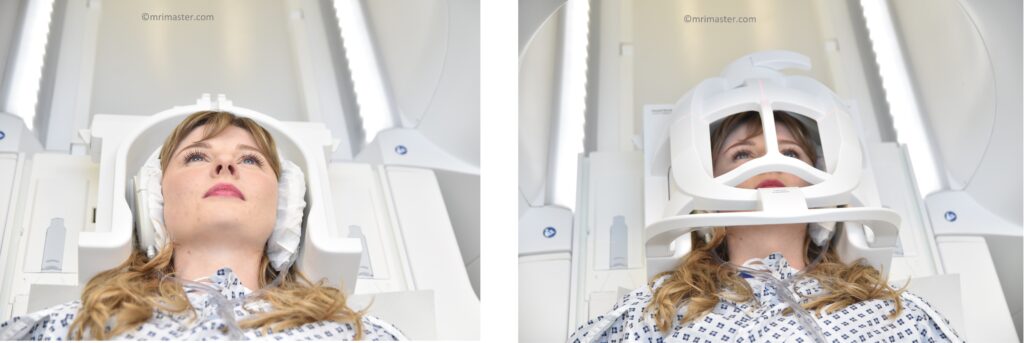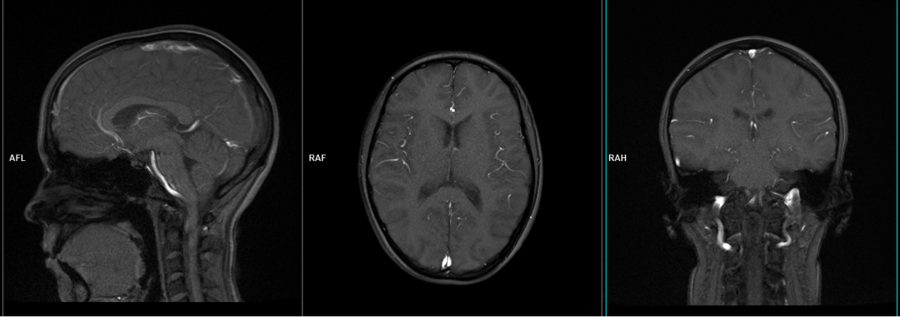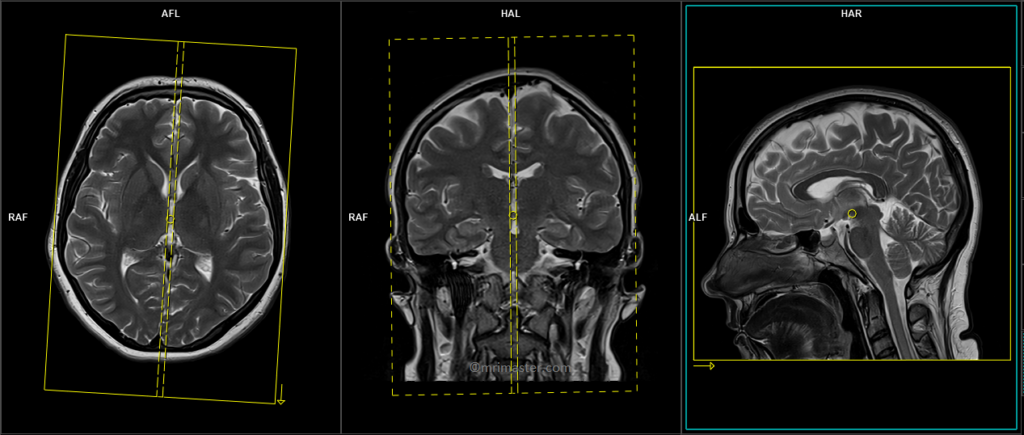MRI Brain : Protocol and Planning
Common Indications for MRI of the Brain
- Transient ischaemic attack (TIA), cerebrovascular attack (CVA)
- Infection, inflammation, meningitis, encephalitis, HIV, AIDS, TB
- Cognitive decline, neurodegenerative disorders, dementia
- Demyelinating disease, multiple sclerosis
- Loss of consciousness, seizures, epilepsy
- Brain tumour, metastases, abscess
- Cerebellar lesion, brainstem lesion
- Congenital abnormalities
- Post-operative follow-up
- Vascular pathologies
- Headaches
- Haemorrhage
Please check our new video tutorial for protocols and planning
Contraindications
- Any electrically, magnetically or mechanically activated implant (e.g. cardiac pacemaker, insulin pump biostimulator, neurostimulator, cochlear implant, and hearing aids)
- Intracranial aneurysm clips (unless made of titanium)
- Pregnancy (risk vs benefit ratio to be assessed)
- Ferromagnetic surgical clips or staples
- Metallic foreign body in the eye
- Metal shrapnel or bullet
Patient preparation for MRI brain
- A satisfactory written consent form must be taken from the patient before entering the scanner room
- Ask the patient to remove all metal objects including keys, coins, wallet, cards with magnetic strips, jewellery, hearing aid and hairpins
- If possible provide a chaperone for claustrophobic patients (e.g. relative or staff )
- Contrast injection risk and benefits must be explained to the patient before the scan
- Gadolinium should only be given to the patient if GFR is > 30
- Offer earplugs or headphones, possibly with music for extra comfort
- Explain the procedure to the patient
- Instruct the patient to keep still
- Note the hight and weight of the patient
Positioning for MRI brain
- Head first supine
- Position the head in the head coil and immobilise with cushions
- Give cushions under the legs for extra comfort
- Now, connect the top portion of the head coil and secure it in place.
- Centre the laser beam localiser over the glabella

Recommended MRI Brain Protocols and Planning
Brain localiser
A three-plane localizer must be taken at the beginning to localize and plan the sequences. Localizers are usually less than 25 seconds and are T1-weighted low-resolution scans.

T2 tse axial
Plan the axial slices on the sagittal plane and position the block parallel to the genu and splenium of the corpus callosum. Verify the planning block in the other two planes and ensure that an appropriate angle is maintained in the coronal plane, making it perpendicular to the line of the midline of the brain and the 4th ventricle. Ensure that the number of slices is sufficient to cover the entire brain from the vertex to the line of the foramen magnum.

Protocol Parameters of T2
TR 4000-5500 | TE 100-120 | SLICE 3MM | FLIP 130-150 | PHASE R>L | MATRIX 320X320 | FOV 210-230 | GAP 10% | NEX(AVRAGE) 2 |
T2 FLAIR axial
Plan the axial slices on the sagittal plane and position the block parallel to the genu and splenium of the corpus callosum. Verify the planning block in the other two planes and ensure that an appropriate angle is maintained in the coronal plane, making it perpendicular to the line of the midline of the brain and the 4th ventricle. Ensure that the number of slices is sufficient to cover the entire brain from the vertex to the line of the foramen magnum.

Protocol Parameters of FLAIR
TR 7000-9000 | TE 110 | FLIP 130 | NEX 2 | SLICE 3MM | MATRIX 320X320 | FOV 210-230 | PHASE R>L | GAP 10% | TI 2500 |
RESOLVE DWI axial
Plan the axial slices on the sagittal plane and position the block parallel to the genu and splenium of the corpus callosum. Verify the planning block in the other two planes and ensure that an appropriate angle is maintained in the coronal plane, making it perpendicular to the line of the midline of the brain and the 4th ventricle. Ensure that the number of slices is sufficient to cover the entire brain from the vertex to the line of the foramen magnum.

RESOLVE DWI: RESOLVE is an advanced technique used to obtain high-quality and high-resolution DWI (diffusion-weighted imaging) images, particularly in body regions affected by susceptibility artifacts. It offers sharp imaging with minimal distortions and provides excellent spatial resolution. RESOLVE is especially valuable for evaluating smaller lesions in a wide range of DWI and DTI (diffusion tensor imaging) examinations. By combining RESOLVE with Simultaneous Multi-Slice (SMS) acceleration, acquisition time can be significantly reduced, improving both speed and imaging capabilities. RESOLVE finds application in various clinical fields, including neurology, oncology, and pediatric imaging. Its outstanding balance between imaging speed and quality makes it superior to other diffusion-weighted imaging sequences. Benefits of RESOLVE include high-quality DWI and DTI, reduced susceptibility and blurring artifacts, insensitivity to motion-induced phase errors, lower specific absorption rate (SAR) compared to TSE-based methods, and compatibility with iPAT for faster scans and further reduced distortions.
Protocol Parameters of RESOLVE DWI
TR 7000-9000 | TE 70 115 | FLIP 180 | NXA 1 2 | SLICE 3MM | MATRIX 192X192 | FOV 210-230 | PHASE R>L | GAP 10% | B VALUE 0 |
T1 SE coronal
Plan the coronal slices on the sagittal plane and angle the planning block perpendicular to the line along the genu and splenium of the corpus callosum. Verify the planning block in the other two planes. Ensure that an appropriate angle is maintained in the axial plane, perpendicular to the midline of the brain. The number of slices should be sufficient to cover the entire brain from the frontal sinus to the line of the occipital protuberance.

Protocol Parameters of T1
TR 500-700 | TE 15-25 | SLICE 3MM | FLIP 90 | PHASE R>L | MATRIX 304X304 | FOV 210-230 | GAP 10% | NEX(AVRAGE) 2 |
T2 tse sagittal
Plan the sagittal slices on the axial plane and position the block parallel to the midline of the brain. Verify the planning block in the other two planes. Angle the planning block appropriately in the coronal plane, ensuring it is parallel to the line along the midline of the brain and the 4th ventricle. Make sure that the number of slices is sufficient to cover the entire brain from one temporal lobe to the other.

Protocol Parameters of T2 Sagittal
TR 4500-6000 | TE 100-120 | SLICE 3MM | FLIP 130-150 | PHASE A>P | MATRIX 320X304 | FOV 210-230 | GAP 10% | NEX(AVRAGE) 2 |
Indications for contrast-enhanced brain scan
- Tumour, Metastases, Cranial nerve lesion, Indeterminate intracranial lesion, IAC mass
- Cavernous angioma, Amyloid angiopathy, Neurocysticercosis
- Meningitis, Encephalitis, Leptomeningeal spread
- Multiple Sclerosis, AVM, HIV, Infection Abscess
- Leukodystrophies, Delayed development
- Syringomyelia(Syrinx)
Optional epi DWI planning for the old generation scanners
DWI epi 3 scan trace axial
To minimize air-bone interface artifacts, plan the DWI axial slices on the sagittal plane with the planning block angled parallel to the line connecting the glabella and the foramen magnum. It is important to note that older generation scanners can create such artifacts. For epi DWI scans, a different angle is used compared to other axial scans, aligning it with the glabella and foramen magnum. Make sure to verify the planning block in the other two planes and determine an appropriate angle in the coronal plane that is perpendicular to the line of the 3rd ventricle and brainstem. Additionally, ensure that the slices adequately cover the entire brain from the vertex to the foramen magnum.

Protocol Parameters of epi DWI
TR 7000-9000 | TE 110 | FLIP 130 | NXA 4 | SLICE 4MM | MATRIX 192X192 | FOV 210-230 | PHASE R>L | GAP 10% | B VALUE 0 |


